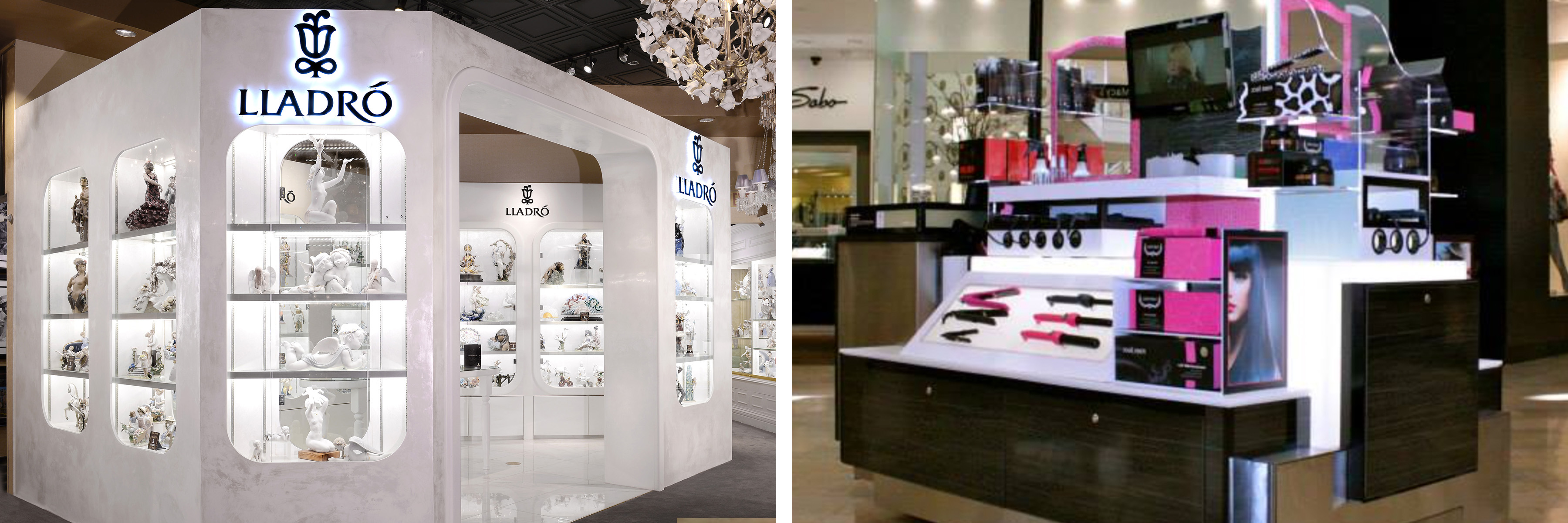Today, businesses are spending the majority of their time and resources trying to become more competitive and grow for the future. Creating a custom kiosk design can be one of the ways to bring a competitive edge to a brick-and-mortar store.
Stages to Creation of Custom Kiosk Design
There are several stages involved in creating custom kiosk designs as part of the overall visual merchandising strategy. This starts with sketching conceptual sketches, followed by reviews by design engineering and producing fabrication drawings and 3D CAD models. Depending on the project requirements and timeline, the next step can include constructing a prototype. Prototyping is an excellent way to produce a proof of concept for constructing drawings into the physical space for visual merchandising.
Conceptual Sketches
A professional designer team, such as the visual merchandising group, will usually start by drawing conceptual sketches and follow a methodological approach matching the project requirements. Some common project requirements include overall budget, target launch date, installation, and expandability. The design team incorporates several design best practices in the conceptual sketches phase to ensure the result is on target.
A sophisticated designer team will account for the customer’s brand guidelines and the end user’s uses cases. The team will consider the use of cases relevant to the target audience to ensure a custom kiosk that is on target. Regardless of design detail, a high-quality design must produce distinctive characteristics that attract customers and help the business stand out from the competition.
A professional designer is not afraid to incorporate many different design inspirations, from vintage shops to futuristic concepts.
Developing a custom kiosk requires a deep understanding of design aesthetics, functionality, and sheet metal fabrication process. The final design must meet predetermined functional requirements, meet local standards, and satisfy the end user’s needs.
Design Engineering Reviews
After conceptual sketches, the next phase is for industrial engineers to review the custom kiosk designs from a manufacturing and fabrication perspective. To develop the best kiosk solution, experienced engineers will go through several iterations with the sketch designers to bring the designs to life while ensuring the project requirements are met. After several iterations, the engineering team will finally create a series of conceptual renderings ready to be presented to the customer and sales team to validate the style of the kiosk that will best suit their needs. A successful design engineering process will follow several factors:
Follow a methodological approach to guide the engineering team in their development process and prevent catastrophic design failures. A methodological approach ensures quality in every step of the development process and helps the team to catch any design mismatches early before it is too costly to correct.
Follow a design criteria document that includes the internal and external requirements such as the end user’s functional and aesthetic needs, target environment ambient parameters, expected durability, and ease of maintenance.
Comply with the applicable regulatory requirements where the kiosk will be deployed. Delivering custom kiosk designs that meet all regulatory requirements is equally important as producing one that is optimized for the end user’s usability and accessibility.
Perform ‘value engineering’ assessment to minimize the overall cost of the custom kiosk design while maximizing its functionality. This part of the development process identifies areas where the engineering team can improve the final kiosk’s value and reduce the cost of production.
Fabrication Drawings and Prototyping
After the engineering reviews, the industrial engineers will continue translating the design sketches into fabrication drawings. The fabrication drawings are the cornerstone to ensure the correct parts are manufactured and an easy assembly process at the end of the project. Here are some of the essentials components in producing fabrication drawings and prototyping:
Produce 3D Computer-Aided-Drawing (CAD) models that include accurate dimensions and material characteristics to help the engineering team efficiently construct the design sketches with functional mechanical parts.
After identifying the various mechanical components, the next step is to integrate the components into a 3D model design of the final kiosk before fabrication. In this process, the design and engineering team have one more checkpoint for validation with the customers and sales team before proceeding to the actual fabrication process.
Use computer-aided design software to produce an accurate Bill of Material list for fabrication, which is essential to ensure customized kiosks are manufactured and delivered on time with the quality promised to the customer.
Once the parts are fabricated, the components are ready to be assembled for proof of concept. This will be the first-floor model prototype that will be available for touch with just the critical functionalities embedded. It is another touchpoint in the development process to validate the progress against the customer expectations and project requirements.
The Benefits of Custom Kiosk Design
Brick-and-mortar stores are physical businesses that are very common. The custom kiosk can bring benefits to businesses that have brick-and-mortar stores.
A self-service concierge for in-store customers to quickly find products in the store. As most buyers are accustomed to the ease of searching for products online, the custom kiosk will provide the same level of convenience for customers searching for products in the store.
Kiosks allow businesses to offer exclusive promotions to make the in-store shoppers feel valued with unique opportunities not available to the online shoppers.
Custom kiosk designs allow businesses to engage in-store customers with a tactile and audio sensory experience. A versatile custom kiosk should enable retailers to easily modify the sensorial experiences according to their product marketing campaigns.
The Appeal of Custom Kiosk Designs
Businesses use custom kiosks as part of their overall retail visual merchandising to deliver a memorable in-store experience and boost sales. Some innovative designs that were once awe-inspiring to in-store customers will eventually become the standard expectation. Hiring a visual merchandising firm to produce custom kiosk designs enable retailers to continually introduce different in-store experience, which will give the business a competitive edge in the market.

